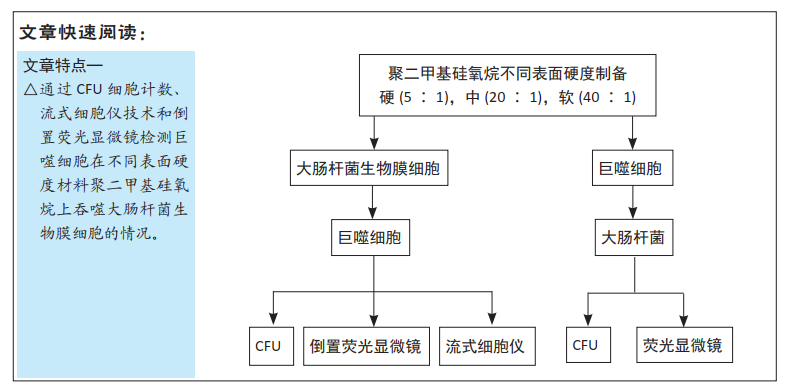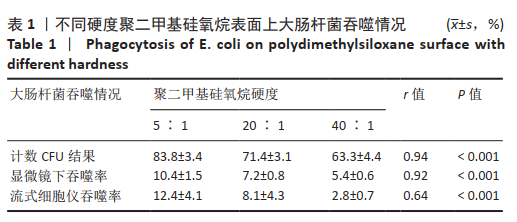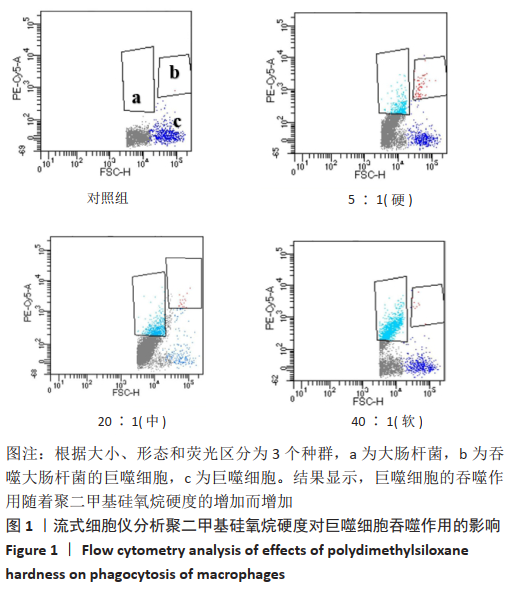中国组织工程研究 ›› 2022, Vol. 26 ›› Issue (10): 1551-1554.doi: 10.12307/2022.202
• 材料力学及表面改性 material mechanics and surface modification • 上一篇 下一篇
生物材料表面硬度在巨噬细胞吞噬大肠杆菌生物膜细胞中的作用
赵彦瑞,周君琳
- 首都医科大学附属北京朝阳医院骨科,北京市 100020
Effect of surface hardness of biomaterials in the phagocytosis of E. coli biofilm cells by macrophages
Zhao Yanrui, Zhou Junlin
- Department of Orthopedics, Beijing Chaoyang Hospital, Capital Medical University, Beijing 100020, China
摘要:  文题释义:
文题释义:
生物膜细胞:当细菌产生细胞外基质并形成生物膜时,这些感染通常会持续存在。由于细胞外基质的保护和缓慢的生长,生物膜细胞所能耐受的抗生素浓度是同一菌株的浮游细胞的500-5 000倍。
吞噬作用:作为先天免疫的主要机制,吞噬作用是巨噬细胞针对入侵病原体的受体介导的免疫应答。在吞噬过程中,巨噬细胞利用表面受体识别病原体,将病原体吞噬到质膜来源的吞噬体中,并最终通过多种策略消灭病原体。
背景:医院获得性感染中有60%-70%与不同材料的医疗器械有关,而细菌生物膜细胞在慢性感染中起着重要作用。细菌的黏附和生物膜形成受生物材料特性的影响,例如表面电荷、疏水性、硬度和表面化学性质。
目的:研究巨噬细胞在不同表面硬度生物材料聚二甲基硅氧烷上对大肠杆菌早期生物膜细胞的吞噬作用。
方法:通过控制基料与固化剂的质量比制备硬(5∶1)、中(20∶1)、软(40∶1)3种表面硬度的聚二甲基硅氧烷。①将大肠杆菌接种于3种硬度材料表面,孵育细菌生物膜细胞,将活化的巨噬细胞滴入各材料表面,通过CFU细胞计数、流式细胞仪技术和倒置荧光显微镜检测巨噬细胞在不同表面硬度材料上吞噬大肠杆菌生物膜细胞情况;②将巨噬细胞接种于3种硬度材料表面,随后加入大肠杆菌,CFU细胞计数检测巨噬细胞在不同表面硬度材料上吞噬大肠杆菌生物膜细胞情况。
结果与结论:①先接种细菌后加入巨噬细胞实验:CFU细胞计数、流式细胞仪技术和倒置荧光显微镜检测显示,随着材料表面硬度的增加,巨噬细胞的吞噬作用增强,大肠杆菌生物膜细胞数量减少,3组间细菌生物膜细胞吞噬率比较差异有显著性意义(P < 0.001);②先接种巨噬细胞后加入细菌实验:CFU细胞计数检测显示,随着材料表面硬度的增加,巨噬细胞的吞噬作用增强,细菌细胞数量减少;显微镜下可见,巨噬细胞在表面硬的材料上更散布、活性更高,并且可见伪足的伸展;③结果表明,随着聚二甲基硅氧烷硬度的增加,巨噬细胞吞噬大肠杆菌生物膜细胞的效率更高,推测通过优化生物材料硬度可以更好地控制内植物相关感染。
https://orcid.org/0000-0002-3957-7419 (赵彦瑞)
中图分类号:


